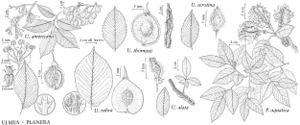Difference between revisions of "Ulmus thomasii"
Silva 14: 102. 1902.
FNA>Volume Importer |
FNA>Volume Importer |
(No difference)
| |
Revision as of 19:54, 24 September 2019
Trees, to 30 m; crowns oblong. Bark gray, deeply fissured with broad, flattened ridges. Wood hard. Branches short-spreading, young branches pubescent, old-growth with 3-5 prominent, irregular, corky wings; twigs reddish, pubescent. Buds brown, ovoid, acute, pubescent; scales brown, pilose on outer surface, ciliate on margins. Leaves: petiole ca. 5 mm, pubescent. Leaf blade obovate to oblong-oval, (2.5-)9-11(-16) × 2.5-5 cm, base oblique, margins doubly serrate, apex short-acuminate; surfaces abaxially white-pubescent, pubescence not tufted in axils of veins, adaxially dark green, usually glabrous, sometimes scabrous. Inflorescences racemose cymes, long-pendulous, (7-)10(-13)-flowered, to 5 cm; pedicel 0.5-1 cm. Flowers: calyx deeply lobed, divided nearly to middle, lobes 7-8; stamens 5-8; anthers dark purple; stigmas greenish, pubescent. Samaras elliptic to oval, 1.5-2.2 cm, narrowly winged, pubescent, margins short-ciliate, apex shallowly notched. Seeds inflated, not thickened. 2n = 28.
Phenology: Flowering spring.
Habitat: Rocky slopes, limestone outcrops, rich woods, flood plains, stream banks
Elevation: 30-900 m
Distribution

Ont., Ark., Ill., Ind., Iowa, Kans., Ky., Mich., Minn., Mo., Nebr., N.H., N.J., N.Y., Ohio, S.Dak., Tenn., Vt., W.Va., Wis.
Discussion
Selected References
None.
